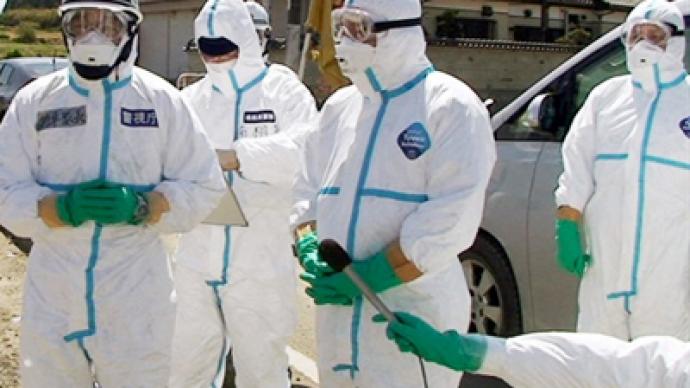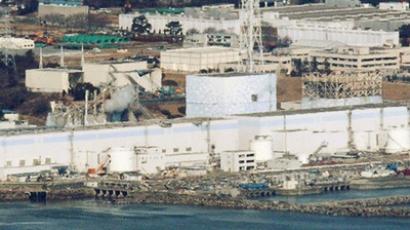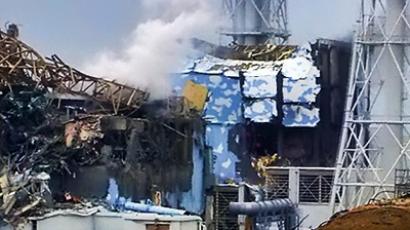Fears Fukushima crisis will worsen as world remembers Chernobyl

While TEPCO is removing contaminated water from reactor 2 of the troubled Fukushima-1 nuclear plant and after successful tests has started spraying resin to prevent the spread of radioactive dust, experts fear deterioration of the crisis.
With Chernobyl's 25th anniversary reminding the world of the terrifying consequences of nuclear safety negligence, many eyes have turned to the continuing crisis in Japan. Dr. Robert Jacobs, an associate professor at the Hiroshima Peace Institute, says that the crisis at Fukushima-1 nuclear plant is far from being resolved. The plant, which was hit by a powerful earthquake and tsunami on March 11, and several aftershocks, was not designed to withstand such massive disasters, according to Dr. Jacobs. The plant now is only relatively stable, given that the roofs over the reactors are holding but could collapse at any time.Dr. Jacobs is critical of the Japanese government saying it withheld important information about the state of affairs at Fukushima-1.“There was just recently an assessment of the situation at Fukushima by a group of international nuclear experts. The picture they painted was far grimmer than the picture that is painted by TEPCO or by the Japanese government. Both the Japanese government and TEPCO have strong interest in downplaying the problem, downplaying the threat and downplaying the impact. There is no doubt that we will need an independent inquiry,” says Dr. Jacobs.Dr. Jacobs points out that it is taking TEPCO, the operator of the crippled plant, longer to resolve the crisis than it took to smooth down the Chernobyl disaster. By this period of time, the Chernobyl crisis had been resolved and there was the clean-up of the site. Currently in Japan we do not know what the end game will be, nor do we know how the operation will go, says Dr. Jacobs. Japan's government has announced that it would help pay compensation for loses incurred by the Fukushima disaster. In effect, tax payers are now going to pay for the damages caused by TEPCO. “The situation with the nuclear industry is that the nuclear plants are uninsurable, so everywhere around the world the nuclear plants are insured by public money, not by private money, by taxpayers,” concludes Dr. Jacobs.
Paul Dorfman, a senior researcher at the University of Warwick, says it is difficult to work out what is actually going on at Fukushima and what the risks are. “We know that the ground water underneath Fukushima is 10,000 times over the legal limit,” Dorfman said. “Three reactors in Fukushima had 280 tons of uranium in them; one reactor had 230 kilograms of plutonium, and there is about 1,800 tons of spent fuel that is potentially at risk in Fukushima.”Dorfman also believes the Fukushima incident will not necessarily lead to the downfall of the international nuclear industry.“It is a different story for different folks,” he said. “Germany, the strongest economy in Europe, has clearly stated that it will exit from the nuclear industry by 2020. Italy says no to new building. The Ministry of Economic Affairs in Switzerland says no more new ones will be built. England, it’s a bit of a choice there: there is EDF, the French company that has invested [billions] in nuclear sites in the UK, and… at present it is quite difficult to predict what may or may not happen in the UK. It is interesting to note that out of 350 planned new reactors in the world, 100 are planned for the Pacific area called “the Ring of Fire” that has caused such disasters as at Fukushima.”
Reiner Braun, a program director at the International Network of Engineers and Scientists, says it was “totally irresponsible” of Japan to build nuclear power plants in an area with so much seismic activity. Moreover, the country enjoys a variety of alternative sources of energy. Braun has called for getting rid of nuclear energy and nuclear weapons, citing an inability to control them. There are also economic reasons for staying away from nuclear power, according to Braun.“Nuclear energy is the most expensive energy in the world,” he said. “If we put all the costs together – the cost of developing the energy, the cost of transportation, the cost of producing the energy – then nuclear energy is much more expensive than any kind of energy. The problem is that the main part of this cost is paid by the state – by us as the taxpayers. If you really take the cost of it, it is very simple to say that all alternatives are much cheaper. We have wind, we have solar, we have water, we have many other kinds of renewable energy. The nuclear industry is lying. They are lying for their profit.”
Professor Gerry Thomas from the Chernobyl Tissue Bank Research Center says that Fukushima will be less of a health threat than the Chernobyl disaster in 1986. “The containment around the outside of the reactor core is still virtually intact,” Thomas said. “There is a small leakage of iodine into water, but of course you’ve got the Pacific Ocean there and the Pacific Ocean is a very big sink. So that radiation will get dispersed very quickly. There has not been a huge amount of deposition in the surrounding area. They are right to restrict access to milk and to green-leaf vegetables, in particular those that take up iodine and therefore are contaminated. But actually, the levels are very low, they are much lower than they were in Chernobyl.” Thomas also praised the Japanese for designing a nuclear power plant that could survive such a massive earthquake and tsunami that hit the facility on March 11.
Arnold Gundersen, an energy adviser at Fairewinds Associates Inc., is frustrated with both Tepco and the Japanese government.“They have consistently underestimated the magnitude of the problem,” Gundersen said. “With 50 reactors and fears of power shortages, and associations within the nuclear industry, that combination makes them want to see the absolute best in the situation, when in fact it is much worse than they are willing to admit. It is one thing to keep it calm, and it is another to tell the facts as they really are.”Gundersen believes that the evacuation from the area around the disaster-hit nuclear facility should have happened quicker. In particular, he said, kids and pregnant women should have been evacuated much faster, as “the risk of cancer to a kid is 10-100 times higher for the same exposure than for an adult.”Gundersen is also concerned that a lot of radiation is leaking down into the groundwater. Putting a cap on top of the facility will not solve the downward migration of radiation at all, concluded Gundersen.
Meanwhile, Dr. Arjun Makhijani, president of the Institute for Energy and Environmental Research, says that in spite of the Japanese government’s claims that the situation in Fukushima has stabilized and that they have a solution to end the crisis, he thinks that celebrations are premature. However, he added, the situation is better then it was. “They have to get rid of the radioactive water, they have to install some remote handling equipment for the spent fuel,” he said. “There is a lot of work to do before they can claim… that they are now cooling in a way that can be sustained for a couple of years – because remember, this spent fuel and fuel in the reactors are going to be hot for quite a long time. And the cooling will have to go on for some years.'"














